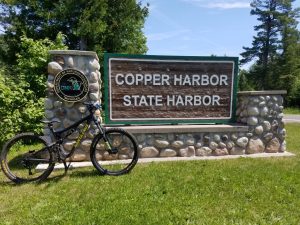I recently spent a week in Colorado and Utah riding various rental bikes. I was tried the Santa Cruz 5010 C, Pivot Mach 5.5, BMC Speedfox 3, and a Devinci DJango. All the bikes rode well, but the Pivot and Santa Cruz stood out as the most fun! When I found an amazing deal on the Santa Cruz 5010, I had to go for it!
My riding style on the previous Salsa El Mariachi 29er and the 26″ Kona Hei Hei was more on the slow and technical side. The Santa Cruz 5010 had me hopping on and over anything I can! I come from a BMX background, riding and racing bikes as a teenager, so this was just amazing to me!
The 27.5 tires grip like crazy, giving you confidence to really carve into turns. With the tires aired down a bit they roll over everything I can throw at them, at least here in Michigan! This could also be due to the suspension working to keep the tires planted over braking stutter bumps, roots or rocks going into turns. Some say there is a drawback to 27.5 on climbs, I have to agree they don’t climb as well as the 29s but it hasn’t been enough to make me want to switch back.
So far it’s been a great bike, fun and easy to ride from the get-go!
[expand title=”Tech Specs” swaptitle=””]
Frame: Carbon C chassis, tapered head tube, forged upper link.
Rear Shock: Fox Float Performance, 130mm
Fork: Fox Rhythm, 130mm
Headset: Cane Creek 10 series tapered, cartridge bearing
Wheels: WTB STP i23 TCS rims laced to Novatec D711 110x15mm front hub and Novatec D712 148x12mm rear hub w/ DT 14 gauge spokes, alloy nipples
Front Tire: Maxxis Minion DHF EXO 27.5×2.3, Tubeless Ready
Rear Tire: Maxxis Crossmark 2 27.5×2.25, Tubeless Ready
Cassette: SRAM XG1150, 10-42t, 11-speed
Chain: SRAM PC1110, 11-speed
Rear Derailleur: SRAM NX, 11-speed
Crankset: Race Face Aeffect, 32t
Shifter: SRAM NX
Brakes: SRAM Level T with Avid Centerline 180mm Rotors
Handlebars: Race Face Ride 760mm, 35mm clamp
Stem: Race Face Ride
Saddle: WTB Volt Race
Seatpost: Race Face Ride
Grips: Santa Cruz Palmdale Lock-on
Weight: 29.43 lbs
[/expand]
[expand title=”Geometry” swaptitle=””]
| Seat Tube
(c-t) |
Effective Top Tube
(eTT) |
Stack
(S) |
Reach
(R) |
Stand Over | Head Tube
(HT) |
Head Tube Angle
(HT°) |
Seat Tube Angle
(ST°) |
Bottom Bracket Height
(BBH) |
Chainstay
(CS) |
Wheelbase | |
|---|---|---|---|---|---|---|---|---|---|---|---|
| S | 15.6in | 22.6in | 23in | 15.9in | 27.9in | 3.9in | 67° | 73.8° | 13.1in | 16.7in | 44in |
| M | 16.5in | 23.5in | 23.4in | 16.7in | 28.2in | 4.3in | 67° | 73.8° | 13.1in | 16.7in | 45.9in |
| L | 17.7in | 24.4in | 23.7in | 17.5in | 28.3in | 4.7in | 67° | 73.8° | 13.1in | 16.7in | 45.9in |
| XL | 19.5in | 25.7in | 24.1in | 18.7in | 28.8in | 5.1in | 67° | 73.8° | 13.1in | 16.7in | 47.2in |
[/expand]

